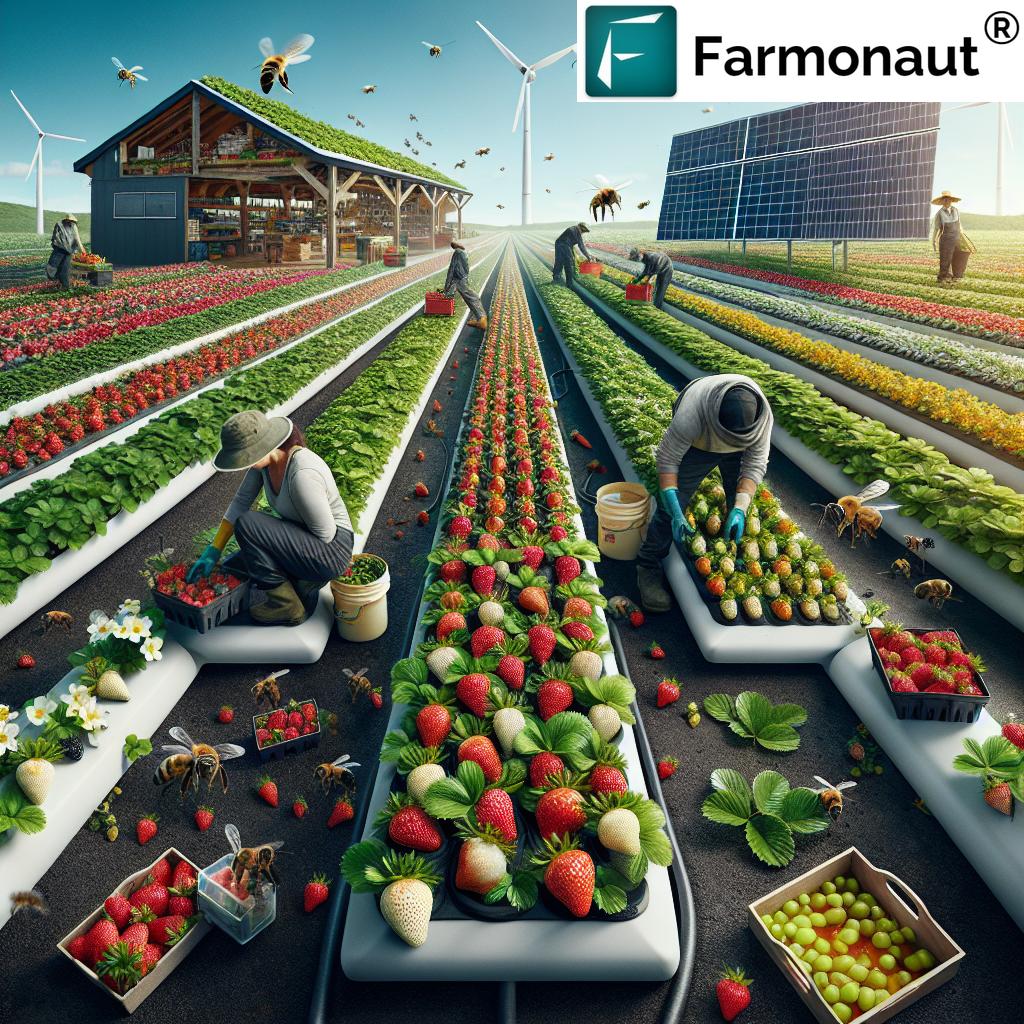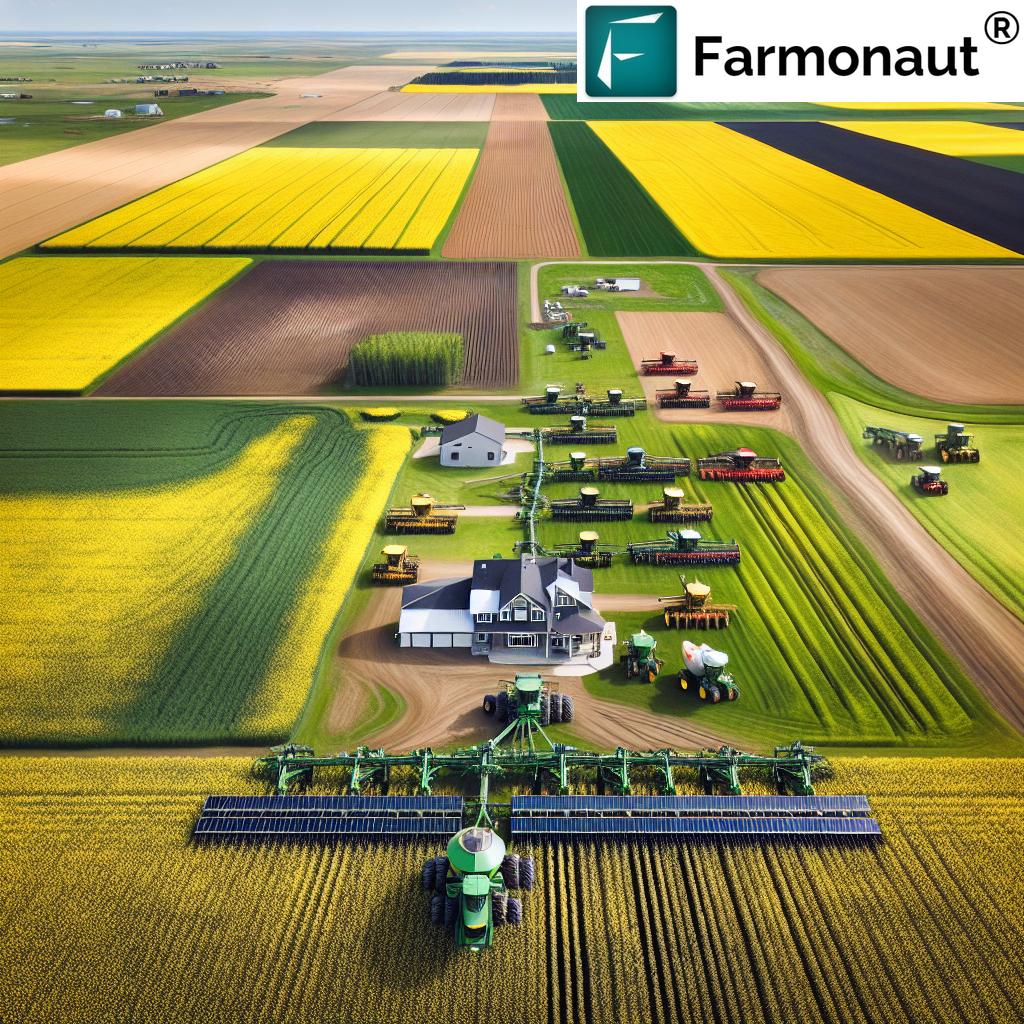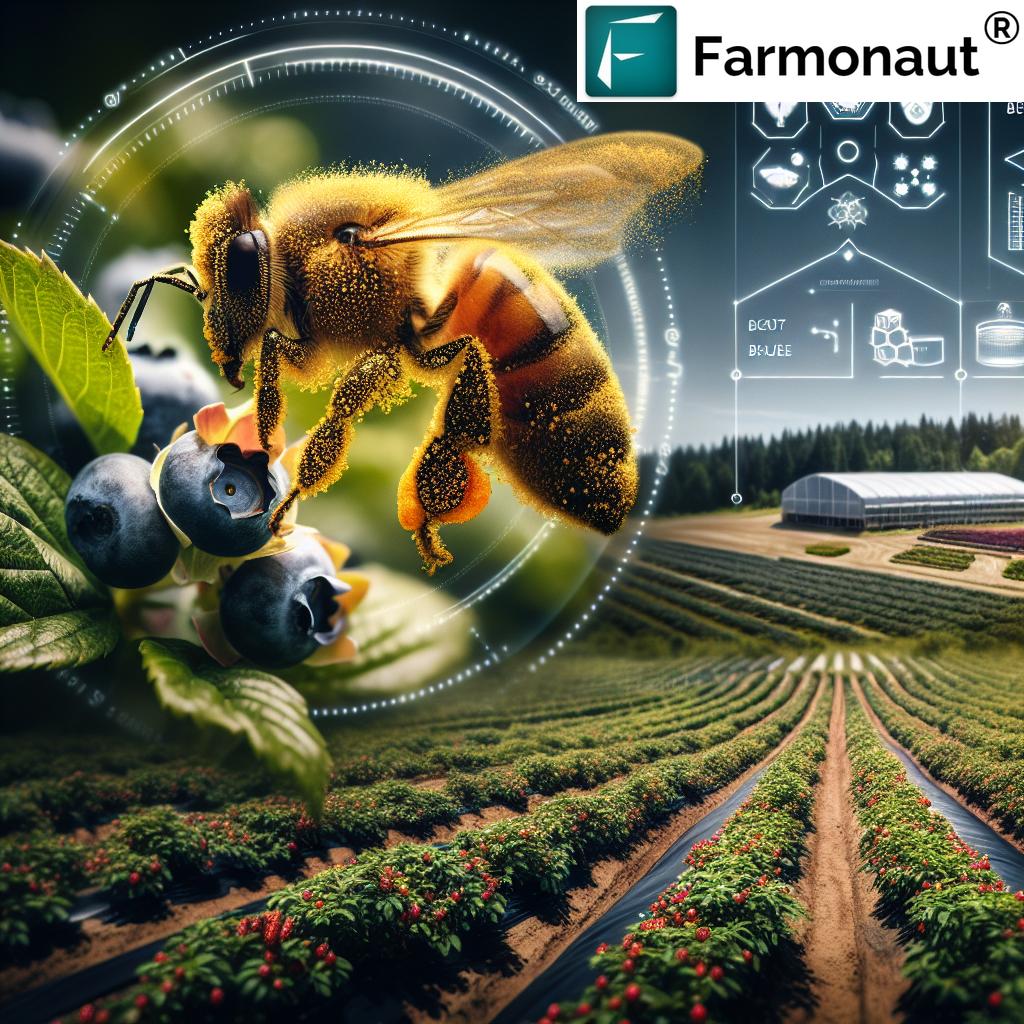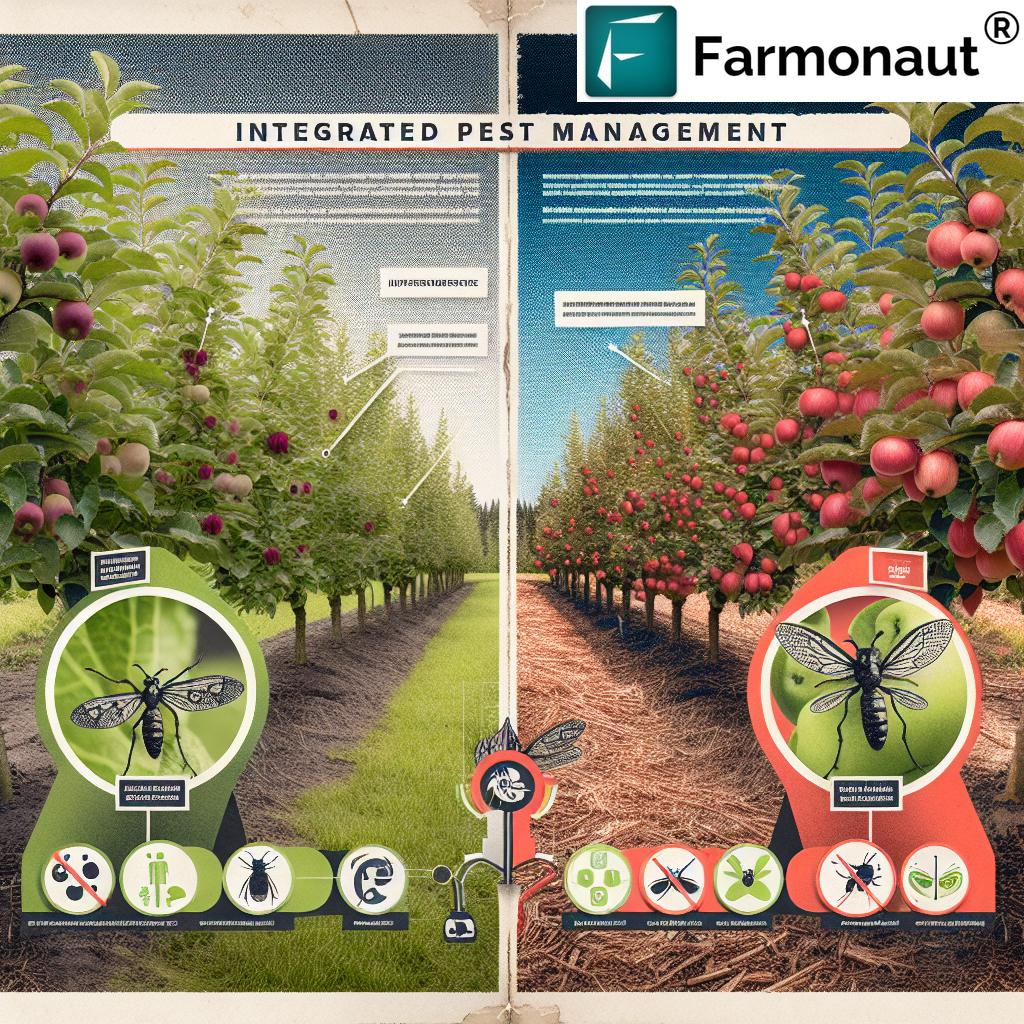Sustainable Strawberry Revolution: How BC Farmers Extend Growing Seasons with Innovative Techniques
In the lush fields of British Columbia, a quiet revolution is taking place. We’re witnessing a transformation in sustainable strawberry farming that’s changing the landscape of Canadian agriculture. From the fertile Fraser Valley to the picturesque fields of Victoria, BC farmers are embracing innovative techniques to extend the growing season of one of our favorite fruits. This blog post delves into the world of modern strawberry cultivation, exploring how day-neutral varieties and cutting-edge methods are reshaping the industry.

“BC farmers have extended the strawberry growing season from 4-6 weeks to 5-6 months using day-neutral varieties and innovative techniques.”
The Rise of Day-Neutral Strawberry Varieties
At the heart of this agricultural revolution are day-neutral strawberry varieties. Unlike traditional June-bearing strawberries, these innovative plants are not sensitive to day length, allowing them to produce fruit continuously from late spring through fall. This breakthrough has fundamentally changed how we approach strawberry cultivation in Canada.
- Extended growing season: From 4-6 weeks to 5-6 months
- Increased yield: More berries per plant over a longer period
- Improved market stability: Consistent supply of fresh, local strawberries
The adoption of day-neutral varieties has not only increased production but also improved the sustainability of strawberry farming. By extending the growing season, farmers can make more efficient use of their land and resources, reducing the environmental impact of their operations.
Innovative Growing Techniques in BC Strawberry Production
BC farmers are at the forefront of implementing modern strawberry growing methods that complement the advantages of day-neutral varieties. These techniques focus on optimizing growing conditions and protecting crops from adverse weather, ensuring a bountiful harvest throughout the extended season.
Protective Cultivation in Plastic Tunnels
One of the most significant innovations in BC strawberry farming is the use of protective cultivation in plastic tunnels. These structures offer numerous benefits:
- Weather protection: Shielding crops from rain, wind, and extreme temperatures
- Extended growing season: Creating a microclimate that allows for earlier planting and later harvesting
- Pest control: Reducing the need for pesticides by providing a physical barrier
- Water conservation: Enabling more efficient irrigation practices
“Protective cultivation in plastic tunnels can increase strawberry yields by up to 30% while reducing waste and weather damage.”
The implementation of plastic tunnels has revolutionized strawberry production in BC, allowing farmers to grow high-quality berries consistently, even in less-than-ideal weather conditions. This technique not only boosts yields but also contributes to sustainability by reducing crop losses and minimizing the use of chemical inputs.
Precision Agriculture and Technology Integration
In the digital age, BC strawberry farmers are leveraging technology to enhance their growing practices. Precision agriculture tools, such as those offered by Farmonaut, are becoming increasingly important in optimizing strawberry production.
Farmonaut’s satellite-based crop monitoring system provides farmers with real-time data on crop health, soil moisture levels, and other critical metrics. This information allows growers to make informed decisions about irrigation, fertilization, and pest management, ultimately leading to healthier plants and higher yields.
- Real-time crop health monitoring
- Precise irrigation management
- Early detection of pest and disease issues
- Optimization of resource use
By integrating these advanced technologies, BC strawberry farmers are not only increasing their productivity but also reducing their environmental footprint. The precision provided by tools like Farmonaut ensures that resources are used efficiently, minimizing waste and promoting sustainable farming practices.
The Crucial Role of Pollination in Strawberry Cultivation
While innovative growing techniques are essential, we mustn’t overlook the fundamental role that pollination plays in strawberry production. Honeybees are the unsung heroes of the strawberry fields, ensuring that flowers are properly pollinated to produce those perfect, juicy berries we all love.
- Improved fruit quality: Well-pollinated flowers produce larger, more symmetrical berries
- Higher yields: Effective pollination increases the number of marketable fruits
- Ecosystem support: Encouraging bee populations benefits the wider agricultural landscape
BC farmers are increasingly recognizing the importance of supporting pollinator populations. Many are implementing bee-friendly practices, such as planting pollinator strips and reducing pesticide use, to ensure a healthy ecosystem for these vital insects.
Nutritional Benefits of BC-Grown Strawberries
The efforts of BC farmers to extend the strawberry growing season not only benefit the agricultural sector but also provide consumers with access to fresh, locally-grown berries for a more extended period. These strawberries are not just delicious; they’re packed with essential nutrients:
- High in Vitamin C: Boosts immune system and promotes skin health
- Rich in antioxidants: Helps protect cells from damage
- Good source of fiber: Supports digestive health
- Low in calories: A healthy snack option
By choosing locally grown BC strawberries, consumers not only support local agriculture but also enjoy fresher, more nutritious fruit. The extended growing season means these health benefits are available to Canadians for a more significant portion of the year.

Sustainable Practices in BC Strawberry Farming
Sustainability is at the core of the strawberry revolution in BC. Farmers are implementing a range of environmentally friendly practices to ensure that their operations are not only productive but also kind to the planet.
- Water conservation: Drip irrigation systems and smart water management
- Soil health: Crop rotation and cover cropping to maintain soil fertility
- Integrated Pest Management (IPM): Reducing reliance on chemical pesticides
- Renewable energy: Solar panels for powering farm operations
These sustainable practices are not just good for the environment; they also contribute to the long-term viability of strawberry farming in BC. By preserving soil health and minimizing environmental impact, farmers are ensuring that future generations can continue to enjoy locally grown strawberries.
The Impact of Extended Seasons on Canadian Berry Farming
The success of BC’s strawberry farmers is having a ripple effect across Canadian berry farming. From the fields of Ontario to the farms of Quebec, growers are taking note of the innovative techniques being employed in BC and adapting them to their local conditions.
- Increased competitiveness: Canadian berries available for longer periods
- Reduced reliance on imports: Meeting domestic demand with local produce
- Economic benefits: Extended employment opportunities in rural areas
- Innovation spillover: Techniques applied to other berry crops
The extended strawberry season is not just changing how we grow berries; it’s transforming the entire Canadian fruit industry. As these innovative practices spread, we’re seeing a shift towards more sustainable, locally-focused fruit production across the country.
Challenges and Future Directions
While the sustainable strawberry revolution in BC is impressive, it’s not without its challenges. Farmers face ongoing issues that require continued innovation and adaptation:
- Climate change: Adapting to increasingly unpredictable weather patterns
- Labor shortages: Finding skilled workers for extended seasons
- Market competition: Differentiating BC berries in a global market
- Technology adoption: Keeping pace with rapid technological advancements
To address these challenges, BC farmers are turning to advanced technologies and data-driven solutions. Platforms like Farmonaut are becoming invaluable tools in this effort, providing farmers with the insights they need to make informed decisions and optimize their operations.
The Role of Technology in Modern Strawberry Farming
As we look to the future of strawberry farming in BC and across Canada, technology will play an increasingly crucial role. Farmonaut’s precision agriculture solutions are at the forefront of this technological revolution, offering farmers powerful tools to enhance their operations:
- Satellite-based crop monitoring for real-time insights
- AI-driven advisory systems for optimized decision-making
- Blockchain-based traceability for enhanced food safety and transparency
- Resource management tools for improved sustainability
These advanced technologies are not just improving productivity; they’re helping farmers adapt to changing conditions and meet the growing demand for sustainable, locally-grown produce.
For farmers looking to leverage these technologies, Farmonaut offers several ways to access their platform:
For developers and businesses looking to integrate Farmonaut’s technology into their own systems, the company also offers an API with comprehensive developer documentation.
Comparing Traditional and Innovative Strawberry Farming Methods
To better understand the impact of these innovative techniques, let’s compare traditional strawberry farming methods with the new approaches being used by BC farmers:
| Aspect | Traditional Method | Innovative BC Method |
|---|---|---|
| Growing Season Duration | 2-3 months | 5-6 months |
| Yield per Acre (Estimated) | 8,000-10,000 lbs | 12,000-15,000 lbs |
| Weather Protection | Limited (open field) | High (plastic tunnels) |
| Pollination Method | Natural (wild pollinators) | Managed (honeybee colonies) |
| Sustainability Score (1-10) | 5 | 8 |
| Farmonaut Integration | None | Full (crop monitoring, advisory, resource management) |
This comparison clearly illustrates the advantages of the innovative techniques being employed by BC farmers. The extended growing season, increased yields, and improved sustainability scores demonstrate the significant progress made in strawberry cultivation.
The Future of Sustainable Strawberry Farming in Canada
As we look to the future, the sustainable strawberry revolution in BC serves as a model for the rest of Canada and beyond. The innovative techniques and technologies being employed are not just changing how we grow strawberries; they’re reshaping our approach to agriculture as a whole.
- Continued research into drought-resistant and climate-adaptive varieties
- Further integration of AI and machine learning in farm management
- Expansion of vertical farming techniques for urban strawberry production
- Development of closed-loop systems for maximum resource efficiency
By embracing these innovations and continuing to prioritize sustainability, Canadian strawberry farmers are ensuring a bright future for the industry. As consumers, we can support this revolution by choosing locally grown, sustainably produced strawberries and appreciating the hard work and innovation that goes into every berry.
Conclusion
The sustainable strawberry revolution in BC is a testament to the ingenuity and dedication of Canadian farmers. Through the adoption of day-neutral varieties, innovative growing techniques, and cutting-edge technologies, they’ve extended the growing season, increased yields, and improved sustainability. This transformation not only benefits farmers and consumers but also contributes to a more resilient and environmentally friendly agricultural sector.
As we’ve seen, tools like Farmonaut play a crucial role in this revolution, providing farmers with the data and insights they need to optimize their operations. By leveraging these technologies and continuing to innovate, BC strawberry farmers are setting a new standard for sustainable agriculture in Canada and beyond.
The next time you enjoy a fresh, locally grown strawberry in the middle of summer or early fall, remember the incredible journey of innovation and sustainability that brought it to your table. It’s not just a fruit; it’s a symbol of agricultural progress and a taste of a more sustainable future.
FAQ Section
Q: How have BC farmers extended the strawberry growing season?
A: BC farmers have extended the strawberry growing season by using day-neutral varieties and innovative techniques like protective cultivation in plastic tunnels. These methods allow for production from late spring through fall, extending the season from 4-6 weeks to 5-6 months.
Q: What are day-neutral strawberry varieties?
A: Day-neutral strawberry varieties are plants that are not sensitive to day length for flowering. Unlike traditional June-bearing strawberries, they can produce fruit continuously throughout the growing season, typically from late spring through fall.
Q: How do plastic tunnels benefit strawberry production?
A: Plastic tunnels provide numerous benefits including protection from adverse weather conditions, creation of a favorable microclimate, extended growing season, reduced pest pressure, and more efficient water use. They can increase yields by up to 30% while reducing waste and weather damage.
Q: What role does pollination play in strawberry cultivation?
A: Pollination is crucial in strawberry cultivation. It’s primarily carried out by honeybees, which ensure that flowers are properly pollinated to produce well-formed, high-quality fruits. Good pollination leads to larger, more symmetrical berries and higher overall yields.
Q: How are BC strawberry farmers incorporating sustainability into their practices?
A: BC strawberry farmers are incorporating sustainability through various practices including water conservation techniques, soil health management, integrated pest management, and the use of renewable energy sources. They’re also leveraging precision agriculture technologies to optimize resource use and reduce environmental impact.
Q: What are the nutritional benefits of strawberries?
A: Strawberries are highly nutritious fruits. They’re rich in Vitamin C, antioxidants, and fiber, while being low in calories. These nutrients support immune health, protect cells from damage, aid digestion, and contribute to overall well-being.
Q: How is technology like Farmonaut helping strawberry farmers?
A: Technologies like Farmonaut are helping strawberry farmers by providing real-time crop health monitoring, precise irrigation management, early detection of pest and disease issues, and optimization of resource use. These tools enable data-driven decision-making, leading to improved yields and more sustainable farming practices.
















